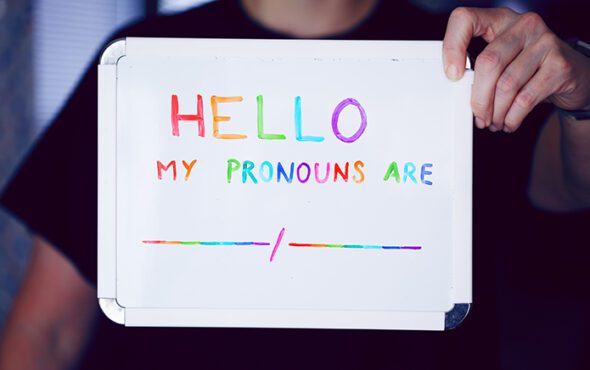
Are you a he or a she? A they or a ze? Telling the world who you are is getting easier as social networking sites from LinkedIn to Instagram roll out pronoun options in profiles to help users clearly express their gender identity.
High-profile transgender and non-binary stars including Hollywood star Elliot Page and singers Sam Smith and Demi Lovato are helping to drive growing awareness of gender minorities – and big businesses are embracing the social shift.
Social networks including Twitter, Instagram and LinkedIn have announced or introduced dedicated pronoun fields in users’ bios, while a host of big companies are also bringing in pronoun policies to encourage inclusion.
But what is the aim – and why are corporations so keen to jump on the bandwagon? Here are the key details.
What are pronoun-sharing schemes and what are their aims?
From trans to genderfluid, androgyne and demigirl, there are dozens of gender identities beyond the binary male and female, with pronouns options ranging from they to ze, fae, and it.
Companies are increasingly inviting staff to share their preferred pronouns in emails or at meetings, while social media firms are offering pronoun options on profiles.
The schemes are designed to be inclusive of people who are transgender or non-binary – meaning they identify as neither male or female – by giving people an easy way to show how they want to be addressed and making it the norm to check.
Why are companies keen to get involved?
Companies are looking to move with the times, but they also have their eye on the bottom line, say experts.
Corporate culture is changing with the entry into the workforce of Generation Z – those born between about 1997 and 2010 – said Ian Johnson, the CEO of LGBTQ+ consulting firm Out Now, which advises clients on LGBTQ+ inclusivity.
“Generation Z are looking to work for organisations where diversity in gender or sexual orientation or expression is not a big problem,” he said.
“Corporations are recognising that the future is going to embrace inclusion and diversity visibly, and they want to be there in order to compete in terms of winning employees.”
Social media firms have gained positive coverage for adopting pronoun options, but critics say they are often less proactive when it comes to tackling online abuse.
There may be an element of “rainbow-washing”, some campaigners say, where companies court positive publicity for supporting LGBTQ+ communities without making any serious commitments.
“But we’re not going to look a gift horse in the mouth,” said Cara English from British trans advocacy group Gendered Intelligence. “It’s a good step towards trans inclusivity, but it certainly can’t be the only step.”
What has been the reaction?
Pronoun schemes have been welcomed by trans and non-binary campaigners, who say they create more inclusive cultures and help tackle stigma and ignorance around gender minorities.
“There’s real positives in being able to be visible,” said J Harrison, a non-binary business analyst at software consultancy firm ThoughtWorks and a campaigner for gender diversity rights.
Harrison said such policies can create an inclusive environment so gender minorities are more likely to be open and worry less about how to bring up their preferred pronouns.
They compared being misgendered – when the given language does not match a person’s gender identity – as like wearing an ill-fitting shirt: a discomfort that slowly becomes unbearable.
“You constantly feel that little bit of pressure … that’s how it feels when you are not able to be yourself,” they said.
But the changes in language have not lacked for critics – some people argue that the popular gender-neutral pronoun ‘they’ is ungrammatical when applied to an individual.
“Most English speakers accept the fact that the language changes over time but don’t accept the changes made in their own time,” said Peter Sokolowski, editor-at-large for the U.S. Merriam-Webster dictionary.
“It will die down over time but I don’t think it will happen overnight. Language changes slowly,” he told the Thomson Reuters Foundation.
What are the pitfalls?
Simply offering a pronoun policy is not enough to support trans and non-binary people, many experts say.
Firms introducing pronoun policies should offer staff the option, said campaigners, but should not impose it as some may not be ready to come out.
Companies must back also back such policies with support and a clear reaction to any discrimination, said gender groups, since many trans and non-binary people face hostility and ignorance in real life along with abuse on social media.
“It’s not a quick fix – you have to keep working at it,” said Bernard Reed of research and advocacy organisation the Gender Identity Research and Education Society, adding firms must be ready to act on issues like harassment and misgendering.
“Trans people are often easily victimised on online platforms,” agreed English. “These organisations need to be working to improve on user experience and safety overall.”
Reporting by Sonia Elks; Editing by Lin Taylor and Lyndsay Griffiths.
GAY TIMES and Openly/Thomson Reuters Foundation are working together to deliver leading LGBTQ+ news to a global audience.



